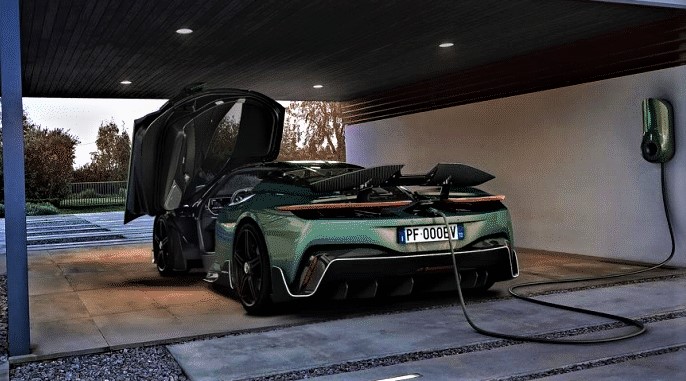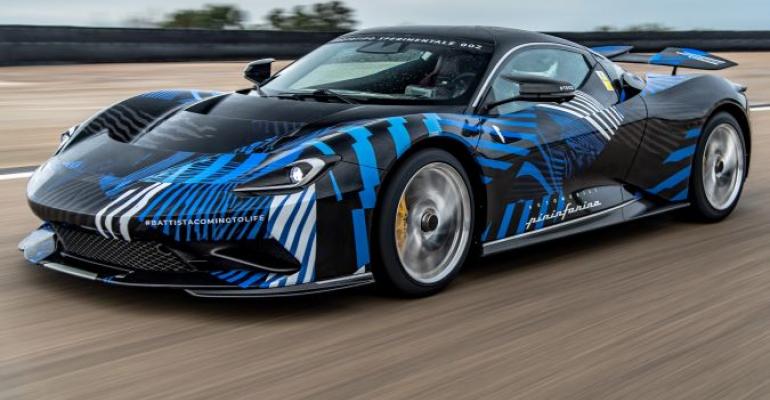Until now, it’s all been about the numbers with the Pininfarina Battista, and they’re rather special: 1,900 hp, 1,696 lb.-ft. (2,300 Nm) of torque and a curb weight under 4,850 lbs. (2,200 kg).
Then there’s the promised performance: 0-62 mph (100 km/h) in less than 2.0 seconds, 0-124 mph (200 km/h) in less than 6.0 seconds, 0-186 mph (300 km/h) in less than 12.0 seconds and a top speed around 217 mph (349 km/h).
No existing combustion-engine road car, not even the magnificent Bugatti Chiron Super Sport, comes close to matching the on-paper credentials of this spectacular new electric-powered all-wheel-drive hypercar – the first product from Pininfarina’s newly created road car division, Automobili Pininfarina.
This was highlighted when we recently got the chance to sit next to Pininfarina’s test driver, former Formula One and Formula E front-runner Nick Heidfeld, in what is being billed as possibly the world’s fastest-accelerating road car for a test session at the Nardo Technical Center in southern Italy.
As our ride-along begins, it is immediately clear the Battista is every bit as breathtaking, if not more so, than the car upon which it is largely based, the Rimac C_Two.
The two electric hypercars have been developed in a parallel engineering program, though the Battista receives its own independently programmed electronics and individually tuned suspension among other key changes.
Obviously, we can’t get an intimate understanding of what the Battista feels like to drive from the lowly position of the heavily bolstered passenger seat. But there’s enough here to tell us it will go down as one of the true pioneers of the electric hypercar genre.
At the heart of the new car are four electric motors, each powering an individual wheel and offering the choice between five different driving modes. The plan is to provide advanced torque vectoring qualities to each axle, though the prototype we’re in does not yet have this function applied.
We can’t say we experienced the full 1,400 kW; the prototype we’re riding in is restricted to a mere 1,000 kW or so due to damp conditions.

Nevertheless, the delivery of power is instant. There’s no delay, just huge and forceful forward propulsion the moment Heidfeld plants his right foot in a straight line. Unlike many EVs conceived for a high top speed, Pininfarina has foregone a 2-speed gearbox for a single-speed unit in the interest of smoothness.
“We’re able to do this because the electric motors rev to around 17,000 rpm,” says Heidfeld.
Yes, the extraordinary way the Battista gathers speed is totally seamless, as if it is connected to a giant elastic band that has been stretched back and let go with each and every determined surge of acceleration.
Steering wheel paddles provide the choice between two levels of energy regeneration, though Heidfeld, who has more experience racing Formula E cars than just about anyone else on the planet, says he prefers leaving it in coast mode, which provides a freewheeling effect during fleeting periods of trailing throttle.
Despite being some 600 hp down on what the definitive production car is planned to receive, the prototype is spine-chillingly quick, thanks to the torrent of torque its quartet of motors delivers.
“There’s a lot about the driving experience that reminds me of a Formula E race car,” Heidfeld says. “But, you know, the crazy thing is the acceleration is even more brutal. For a road car, it is off the scale of everything else I’ve driven.”
Equally as mind-blowing as its acceleration is its stopping ability. The Battista’s Brembo brake system hauls it down from big speeds with great ability. Although there are plans for the sizeable rear spoiler to provide air-brake qualities, it wasn’t triggered on the prototype we rode in.
The turn-in is whip-crack sharp, Heidfeld merely rolling his wrists to align the nose with the apex. You can sense the stiffness. There’s virtually no roll, just a flat and neutral stance as substantial lateral forces build.
The aim of the latest round of tests for the Battista is to narrow down the tire choice. At the moment, Pininfarina has settled on two from Michelin: Pilot Sport 4 and Cup 2R S with a profile of 265/35 R20 front and 325/30 R21 rear.
On the warm-down lap, the 43-year-old German shares some further perspective on the setup: “We’ve focused on fundamentals to make it nice to drive. We don’t want a car that is intimidating. Anyone can drive this car. It feels as much at home on the road as it does on the racetrack.”
We’ll have to wait before we can deliver our own verdict – and evaluate Pininfarina’s claim that its 120-kWh lithium-ion battery (below) provides a range of up to 311 miles (501 km).
But we’ve learned enough to know the $3 million Battista will be something special when the first of a planned 150 units rolls off the company’s production line in Turin, Italy, and is delivered to the first customer later this year.






